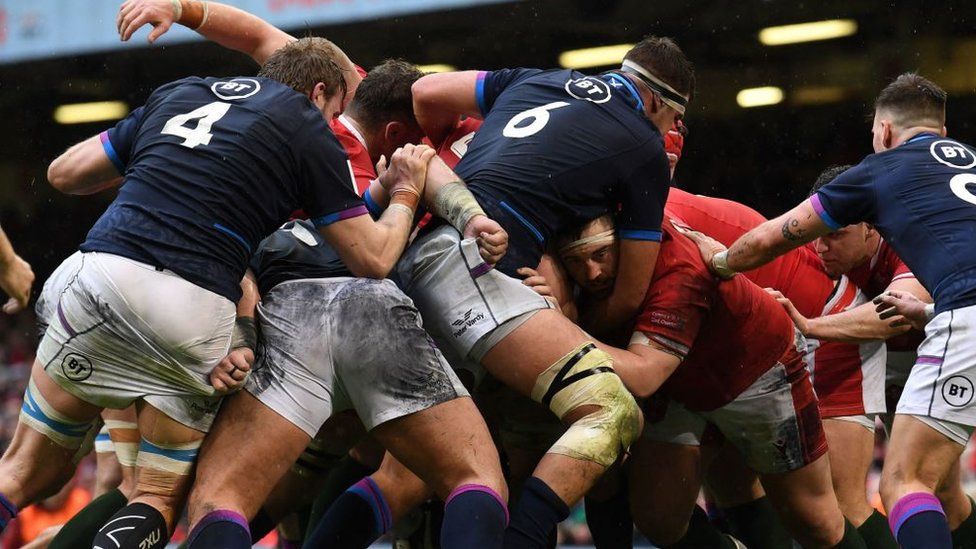ARTICLE AD BOX
 Image source, Getty Images
Image source, Getty Images
The study looked at former Scotland rugby international players
An expert has called for "immediate research" after a study suggested that elite rugby union players could be at increased risk of brain conditions like motor neurone disease.
The study examined a link between sport and neurodegenerative diseases such as Parkinson's, MND and dementia.
Scientists said the study should encourage "dramatic changes" in rugby to reduce the risks of brain injury.
The MND Association said the study raised "more questions than answers".
The research team was led by consultant neuropathologist Professor Willie Stewart, honorary professor at the University of Glasgow.
It looked at former Scotland rugby international players from both the amateur and the professional period.
The research team compared health outcomes among 412 former Scotland international male rugby players with more than 1,200 individuals from the general population.
The results showed that the rugby players, all of whom were born before 1991, were more likely to die at a slightly older age than peers of similar age and socioeconomic status.
Urgent action needed
While they had a higher risk of death overall from neurodegenerative disease, they were less likely to die of respiratory disease.
Their chances of being diagnosed with a neurodegenerative disease were 2.67 times higher.
By far the biggest risk was for MND, with rugby players 15.17 times more likely to be diagnosed than people of the same age range in the general population.
The overall number of MND cases in the study is not known, although it is understood to be small.
Former internationalists were also three times more likely to develop Parkinson's and two times more likely to develop dementia.
The debate on brain health and contact sports such as rugby and football is gathering momentum.
There are no definitive answers but a series of research studies, including this latest one from the University of Glasgow, add weight to the suspicion that elite players are more at risk than those in the wider population.
Care has to be taken about drawing firm conclusions especially if the numbers of players surveyed is relatively small.
But the research team, led by Professor Willie Stewart, having previously carried out a landmark study of the dementia risk among former professional footballers, has now further underlined the need for further research on the impact of concussion and other head injuries on the longer-term health of rugby players.
The results have been published as part of the FIELD study, which was funded by the Football Association and the Professional Footballers Association.
Prof Stewart - who led previous research that found former footballer professionals are three-and-a-half times more likely to die of dementia than the general population - called for further investigation.
"Of particular concern are the data on motor neurone disease risk among our rugby players, which is even higher than that for former professional footballers," he said.
"This finding requires immediate research attention to explore the specific association between rugby and the devastating condition of motor neurone disease."
At at briefing ahead of the study's publication, the academic said urgent action was needed by rugby authorities.
Professor Willie Stewart is leading the research into football and rugby players
He welcomed moves to reduce high-impact training between matches, but said the pace of change was "slow".
"This should be a stimulus to them to really pick up their heels and start making pretty dramatic changes as quickly as possible to try and reduce risk," Prof Stewart said.
"Instead of talking about extending seasons and introducing new competitions and global seasons, they should be talking about restricting it as much as possible.
"So cutting back on the amount of rugby we're seeing, getting rid of as much training as possible. Things like that have to be addressed pretty, pretty rapidly."
The study, published in the Journal of Neurology, Neurosurgery and Psychiatry, showed about three out of four of the rugby players with dementia had chronic traumatic encephalopathy, a specific pathology linked to brain injury exposure.
It also found that unlike in football, there was no sign of increased risk depending on position on the field.
Dr Brian Dickie, director of research development at the Motor Neurone Disease Association, said the new study added weight to previous reports from the FIELD team on increased risk of neurodegeneration in football players, although the new study was considerably smaller.
However, he said it raised "more questions than answers".
Image source, Getty Images
Image caption,A previous Scottish study called for mandatory protective headgear at all levels of the game
"For example, it is not clear exactly how many players were diagnosed with MND, though from the information provided, that absolute number will be small," he said.
"It is also surprising that there were no cases reported in the larger control group, as MND is the most common neurodegenerative disease of mid-life and the study population appears to include people in the 'high risk' age range of 50-80 years.
"Moreover, we know that the vast majority of cases of MND involve a complex mix of genetic and environmental risk factors, so the level of genetic risk may be different in high-performance athletes compared with the general population."
Dr Jane Haley, director of research at MND Scotland, said: "We welcome this very interesting piece of research. While the initial results do seem concerning, the study is based on a small sample size which means that, because MND is a relatively uncommon condition, larger studies will be needed to determine whether this result can be confirmed more widely.
"A connection between elite level sports and MND has been proposed before, but this is the first time an increased risk has been indicated for rugby players. The reasons for these apparent increases are not yet known and need to be explored further."

 2 years ago
25
2 years ago
25








 English (US) ·
English (US) ·